McBroom Family
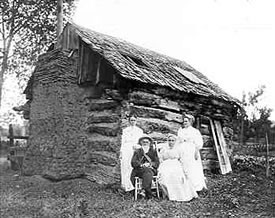
John McBroom cabin on Bear Creek, c.1910. Seated is Isaac McBroom, brother of John; and Isaac's wife Emma. Standing at left is Mrs. McBroom Playter, daughter of Isaac; and at right is Mrs. Etta Neuiheiser, who was in the same wagon train crossing the plains.
Two McBroom brothers, John and Isaac, claimed land early in Colorado's Platte Valley south of Denver near Bear Creek in the area that is now Sheridan and Fort Logan. The one who came first was John McBroom. He was born July 26, 1822 in Kentucky. Following a typical migration pattern of that time, his family crossed into Indiana and settled near Crawfordsville in Montgomery County, about 1825. There his younger brother, Isaac E. McBroom, was born April 22, 1830. Their parents were Joseph and Phoebe (Young) McBroom, both Virginia natives.
About 1843 the family moved to the area of St. Joseph, Missouri. By then John was in his early twenties and, after farming until 1846, was probably ready for adventure. He was in a time and place that gave that opportunity. That part of Missouri was the embarkation point for a frontier that held challenges from the elements, hostile Indians and a war brewing with Mexico.
Most of the details of John's early life are known to us from his biography in Baskin, History of the City of Denver, Arapahoe County, and Colorado, 1880, and from Jerome S. Smiley, History of Denver, 1901. Smiley explains that John came west with A. W. Doniphan's company during the Mexican War and helped put down the insurrection of Mexicans and Indians at Taos. Baskin describes how John served in the quartermaster corps in New Mexico, and indicates that he did not join the army until March 1855. Then he fought against the Ute Indians in southern Colorado. He says that John returned to Fort Union, New Mexico and remained in government employ as wagon and forage master until March 1858.
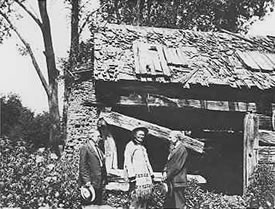
Albert B. Sanford writes: "In the spring of 1860, John McBroom lived in this cabin, located a half mile above the mouth of Bear Creek and near present Fort Logan. He had known Kit Carson in Taos, NM in earlier years and when Carson visited the new settlements on Cherry Creek in 1860, he stayed with McBroom for a short time in the cabin. In 1924, Kit, Carson's son came to Denver and Mr. Frank S. Byers drove Gov. Ammons, Kit and myself to the old place, then almost in ruins." Left to right: F.S. Byers, Kit Carson, and E.M. Ammons, former governor of Colorado. Photo by A.B. Sanford, c.1924.
Next he went with government troops under Captain R. B. Marcy to Utah "to quell the Mormon outbreak," says Baskin. An article in The Colorado Magazine in 1926 by historian Albert B. Sanford tells of this expedition and describes what happened when they got to the mouth of Cherry Creek, the future sight of Denver. The group had left Fort Union about May 1, 1858 with supplies for troops at Fort Bridger. McBroom was head wagon boss. In Colorado at the confluence of Cherry Creek and the Platte River the caravan found the water so high that they had to spend four days building a ferry boat "of hewn timbers and whip-sawed planks" to cross the river.
It was John McBroom's first sight of the Platte Valley, and, while waiting, he decided to explore. He rode up the valley to where Bear Creek enters the Platte and was impressed with the beauty and the desirability of the land for farming. After completing his mission and learning that gold had been discovered in the area a short time later, he decided to return in the spring of 1859 to claim a piece of the valley just south of Bear Creek.
John soon built a log cabin on his claim. A photograph of this cabin in the archives of the Littleton Historical Museum is captioned as if it were the cabin itself speaking: "I was built in the year 1859 and occupied as a residence by John McBroom until 1866 when he got married and deserted me. During the time I was occupied as a bachelor's residence, I entertained the following noted mountaineers: L. B. Stewart, Tom Boggs, Tom Tobin, Calvin Jones, Jim Baker, Col. A. G. Boone, great grandson of Dan Boone, Kit Carson, the noted trapper, and Colorow, the noted Indian chief."
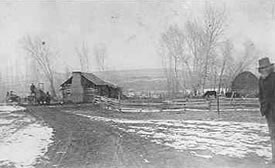
Pioneer cabin of John W. McBroom on Bear Creek, 1887; McBroom on the right.
John McBroom had become acquainted with these men during his years in the west, and had formed an early friendship with Kit Carson, said Sanford. John did get married in 1866 to Emma J. Burnett in Denver. She was the daughter of William Burnett of Terra Haute, Indiana. John and Emma McBroom had five children, according to Baskin. Only three are accounted for. A daughter, Mary Isabella died at age fourteen months. A notice of her death appeared in the Rocky Mountain News in November 1868. Daughter Dora was born August 7, 1878. She married Fred Curkeet April 23, 1902. John and Emma's son, Joseph William "Billy" was born September 4, 1879. More about Billy McBroom appears below.
John McBroom filed his claim on his 160 acres and received the final United States patent for it September 1, 1869. It included three separate pieces of land, described as follows:
- East 1/2 of the Southeast 1/4 of Section 32, Township 4 South, Range 68 West;
- Northwest 1/4 of the Southwest 1/4 of Section 33, Township 4 South, Range 68 West;
- Southwest 1/4 of the Northwest 1/4 of Section 33, Township 4 South, Range 68 West,
all in the Denver Land Office District, Arapahoe County, Colorado.
He constructed the first irrigation ditch from Bear Creek, and when water rights were later adjudicated, his was priority number one.
Sanford explains that John McBroom was one of the few men in Colorado in those days who was not involved in mining. Instead he turned to agriculture and was soon selling sweet corn, watermelon and vegetables. He was among the first to raise grain and planted one of the first orchards. "Strawberries and small fruits were his special delight, and chickens and turkeys were plentiful about his barnyards," says Sanford.
In 1867 he joined Joseph Bowles, John Lilley, Peter Magnes and others to help Richard Little found the Rough and Ready flour mill a little further upstream in Littleton. It was an instant success, and those farmers quickly found a good market in Denver and the mountain towns for every sack of flour ground.
"With agricultural enterprise now linked to mill and market, economic prosperity for the valley seemed assured," writes Robert McQuarie in his 1990 Littleton, Colorado, Settlement to Centennial. But local Indians, including raiding bands of Arapahoe or Cheyenne occasionally descended on farms and ranches, taking livestock and frightening settlers. Sanford says that from 1864 to 1868 John McBroom was captain of the "Bear Creek Rangers," who protected the settlers along the Platte River and Bear Creek. In 1876 he was elected to the Colorado State legislature by a unanimous vote.
John McBroom's original 1859 log cabin still stood on his farm after he had built a newer log one and later a brick house. As it gradually deteriorated and when the land was going to pass out of the hands of McBroom heirs, Sanford says it was turned over to the State Historical Society, who arranged with George Turner to mark each log and have it moved. That was in 1925 or early 1926. Houstoun Waring wrote in the Littleton Independent in 1986 about the cabin's fate. He said that Edwin Bemis, late publisher of the newspaper, had tried to save it, but was too late. Turner's plan was to use the cabin at his miniature village of Tiny Town in Turkey Creek Canyon, and he took down the logs, marking them for re-assembly. But he didn't act quickly enough, and picnickers used the timbers, one by one, until all were consumed in campfires.
John McBroom died January 15, 1891 at his home on lower Bear Creek at age sixty-eight. His wife, Emma, died barely a month later, on February 20, 1891 at age fifty-two. Both are buried in the Littleton Cemetery.
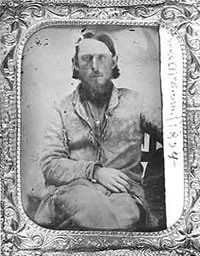
Daguerreotype portrait of Isaac McBroom of Bear Creek, c.1858.
John's younger brother, Isaac Elston McBroom, perhaps did not have such a colorful young life as John's, although it is said that he came to Colorado because of gold fever. He grew to age thirteen in his native Montogomery County, Indiana, then went in 1843 to St. Joseph, Missouri with his family as described above. Historian Baskin says that his father had died several years earlier. In 1850 Isaac moved to Mills County, Iowa and farmed. He married Emma L. Brower in Mills County August 6, 1854. Her tombstone in the Littleton Cemetery gives her birth date as 1836. According to Wilbur Fisk Stone's History of Colorado she had been born in Illinois and was the daughter of Joseph and Cordella (Hussy) Brower, both natives of New York. Her obituary, however, gave her birthplace as Iowa. (The wives of both John and Isaac McBroom were named Emma.)
In spring 1860 Isaac and Emma McBroom crossed the plains to Colorado, bringing with them their baby daughter, Eva, who had been born March 3, 1859. (Eva married Clark Playter in 1901.) They traveled by ox-drawn prairie schooner and arrived in Denver June 16, 1860. Isaac quickly took up land beside his brother in the Platte Valley. He received his United States patent on July 20, 1872 on three pieces of land totaling 162 ½ acres described as:
- North 1/2 of the Northwest 1/4 of Section 5, Township 5 South, Range 68 West;
- Southeast 1/4 of the Northwest 1/4 of Section 5, Township 5 South, Range 68 West;
- Southwest 1/4 of the Southwest 1/4 of Section 32, Township 4 South, Range 68 West.
Isaac is credited with laying out the town of Sheridan, Colorado in 1887.
Isaac also built a log cabin. It was made of cottonwood logs chinked with adobe and had an adobe chimney. It sat on the south bank of Bear Creek, just a few feet west of Federal Boulevard. Isaac's cabin has enjoyed a better fate than John's cabin. In 1959 the Sheridan Historical Association purchased the one and one-half story building and announced plans to restore it as a museum. Kenneth Goff of Sheridan acquired it soon after and presented it as a gift to the Arapahoe County Fair Association with the idea that it would be moved to a picnic area at the County fair grounds and restored. Goff had written a history of Sheridan, Colorado in 1957 in which he described Isaac McBroom's pioneer life and his cabin. It was thought to be the oldest remaining structure in the county.
The cabin was taken apart and moved, but volunteers who had at first been enthusiastic about the idea suddenly vanished when it came time to reassemble the resulting huge pile of logs. Forrest Hammes, secretary-manager of the fair association, made an appeal. The Englewood Junior Chamber of Commerce came to the rescue, and its entire membership gathered in late August 1959 to re-construct the cabin log by log. It was presented to the fair association, along with a plaque, November 15, 1959.
The Isaac McBroom cabin stood at the Arapahoe County fairgrounds until 1987, when after years of efforts by the Littleton Historical Museum to acquire it for its 1860s farm, an agreement was reached. The City of Englewood had meanwhile bought the cabin from the fair association for its historical significance, but they decided to give it to the Littleton museum in a gesture of cooperation. The two cities had worked together in many other ways. Museum Director Bob McQuarie said, "It speaks to the kind of cooperation between families of the 1860s when they didn't worry about division of boundaries." The cabin became the centerpiece of the Museum's 1860s farm where it is augmented by other authentic buildings, livestock and crops.
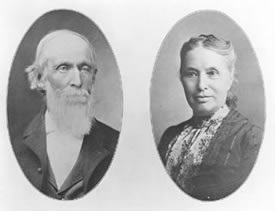
Mr. and Mrs. Isaac (Emma) McBroom in 1904 on the occasion of their 50th wedding anniversary.
Isaac McBroom died October 17, 1914 at his home in what had become Sheridan. He was eight-four. Emma (Brower) McBroom also lived until age eighty-four and died August 23, 1919. Both had been members of the Society of Colorado Pioneers. They are buried in the Littleton Cemetery.
Joseph William "Billy" McBroom, son of John and Emma (Bennett) McBroom, was born in his parents' log cabin in 1879. He married Bertha M. Smith April 22, 1903 in St. Paul's Episcopal Church on Rapp Street in downtown Littleton. Her grandfather, the Rev. Francis Byrne, who had been pastor at St. Paul's 1886-1891, helped perform the ceremony.
Billy McBroom was known as "the colorful sheriff of Arapahoe County." He was the county sheriff from 1915 to 1917. In 1915 he made headlines by capturing Denver bandit "Candy Kid" Tyler after pursuing him and another man from Littleton into the mountains. Later he joined the United States narcotics and alcohol division where he served for fifteen years. Then he returned to the ranch on Bear Creek and farmed.
Billy was a longtime member of Weston Masonic Lodge and in 1912 was its Worshipful Master. As a young man in 1902, he made application to the lodge with the endorsement of H. H. Shepperd, who was then Master of the Lodge, and Rudolph Candler. When he thought he was prepared for his first examination, he appeared at the lodge, apparently unexpected. No one was there who was qualified to ask him the questions, but the secretary tried. After Billy had prompted him several times, he directed Billy to ask himself the questions and give the answers. "I guess it was satisfactory, because they passed me," said Billy in the lodge's printed history.
Billy's wife, Bertha Smith, was born February 19, 1881 at Fort Collins, Colorado. In 1889 she came to Littleton with her parents, Emily and I. A. Smith. She was active in the Manzanita Chapter of Eastern Star and was elected Worthy Matron in 1915 and Grand Ruth of the Grand Lodge in 1916. She died December 21, 1926 from appendicitis at age forty-five. Joseph William "Billy" McBroom lived until December 16, 1962 and died at age eighty-four. The couple had no children, but Billy's obituary said he was survived by a foster son, H. J. Harwager, "in the Navy on Guam." Billy and Bertha McBroom are buried in the Littleton Cemetery along with the other McBrooms described here.
Bibliography
Arapanews, Official Organ of the Arapahoe County Fair. Littleton, Colorado: Arapahoe County Fair Association, (date?-)
The Denver (Colo.) Post. Denver: Colorado: The Denver Post Publishers, 1895-
Freemasons of Littleton, Colorado, Weston Lodge Number 22, A. F. & A. M., 1872-1973. Littleton, Colorado: A. F. & A. M., 1973.
Goff, Kenneth. The History of Sheridan, Colorado, 1858-1956. Sheridan, Colorado: Sheridan Historical Society, 1957.
History of the City of Denver, Arapahoe County, and Colorado. Chicago: O. L. Baskin, 1880.
Littleton (Colo.) Independent. Littleton Independent Publishers, 1888-
Littleton Museum. Card files: McBroom; Photographic archives; Vertical file: McBroom.
McBroom, J. W. "History of the McBroom Ditch." Manuscript copy, (no date).
Rocky Mountain News. Denver, Colorado: The Rocky Mountain News Publishers, 1859-
Sanford, Albert B. "A Colorado Pioneer and His Cabin." The Colorado Magazine. Denver, Colorado: The State Historical Society of Colorado, 1923-
Smiley, Jerome S. History of Denver. Denver, Colorado: The Denver Times Publishing Company, 1901.
Steele, Lawrence. The Roots of Prosperity; Littleton in the 1860s. Littleton, Colorado: Littleton Historical Museum, 1982.
Stone, Wilbur Fisk. History of Colorado. 4 volumes. Chicago: S. J. Clarke, 1918-1919.
Photographs courtesy of the Littleton Museum unless otherwise noted. To order copies, contact the museum at 303-795-3950.
Compiled by Doris Farmer Hulse
Updated April 2021 by Phyllis Larison